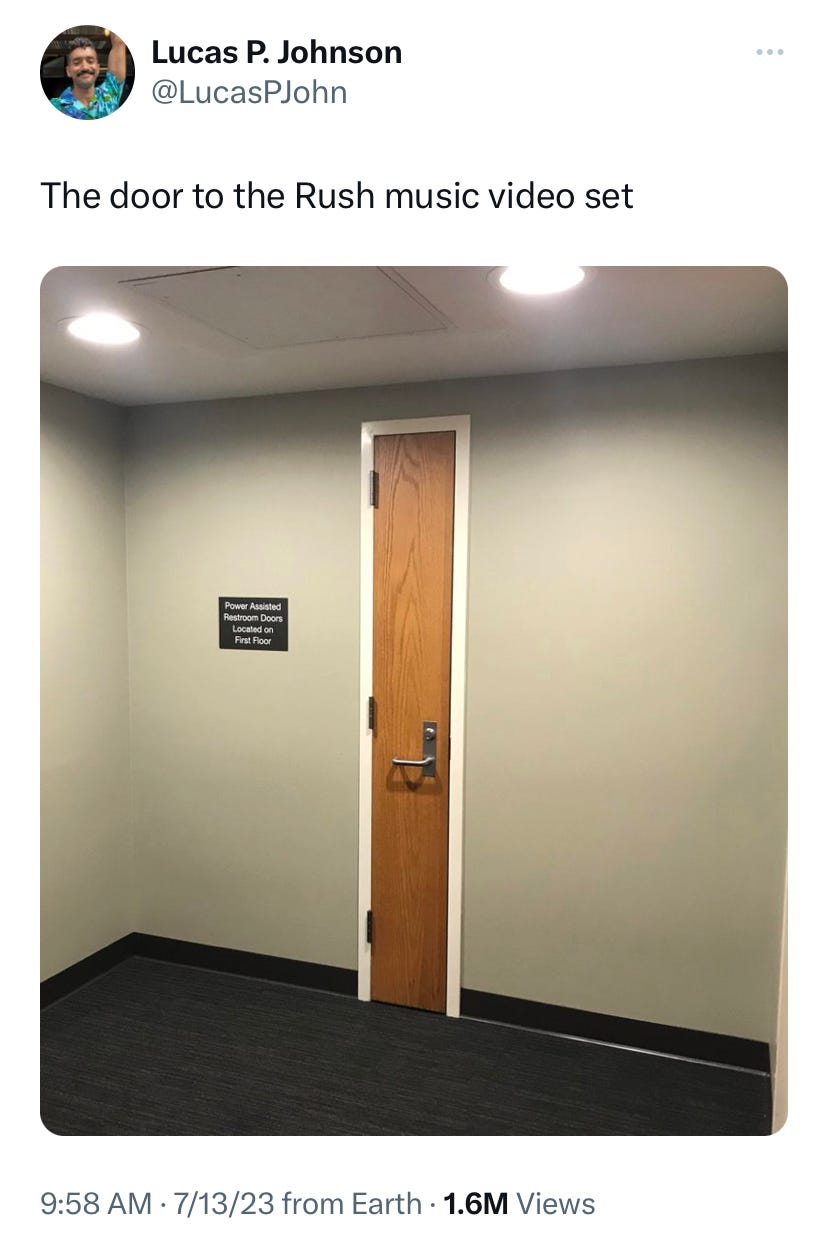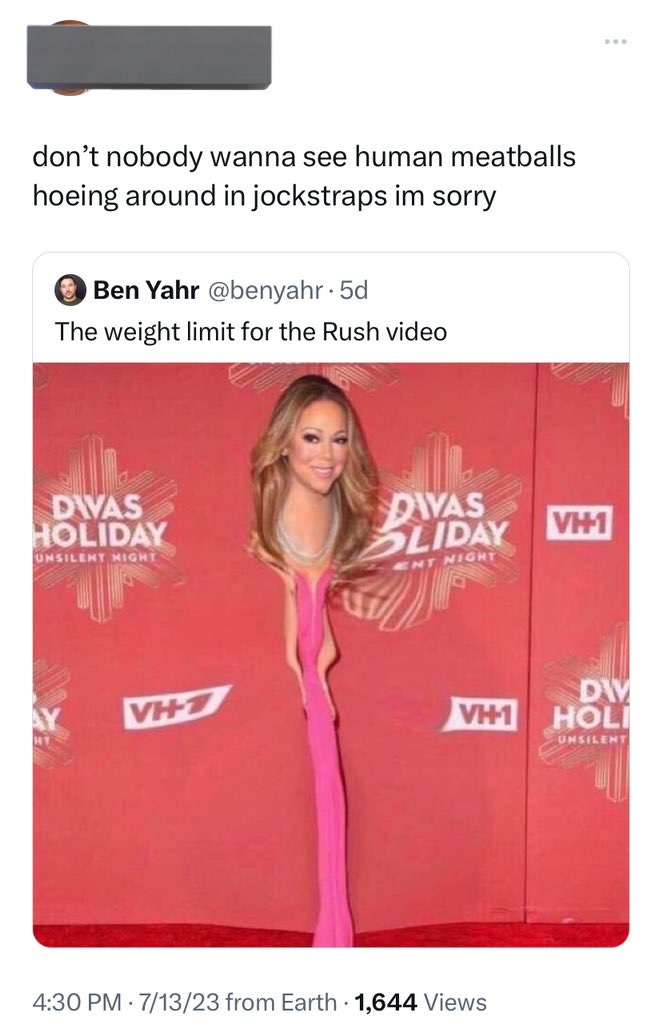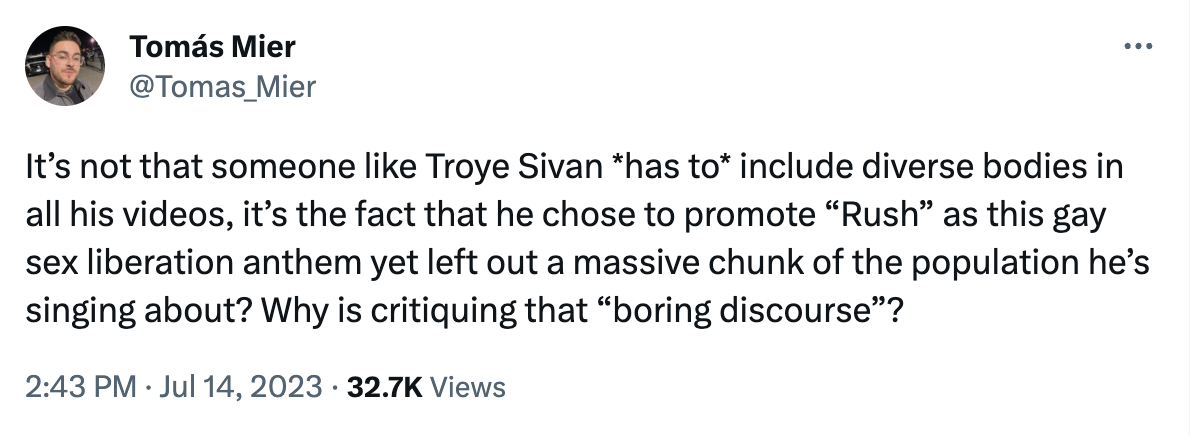Last week, I shared some of the music getting me through what has, even in the past week, proved to be a tough year. That piece came a week too early to include a new contender for Song of the Summer (well, at least in the gay bars). I am, of course, referring to “Rush,” the lead single off of Troye Sivan’s Something to Give Each Other. Sivan has been edging his audience with snippets of the song for weeks on TikTok, puzzlingly passing up a June release to coincide with LGBT+ Pride month. I use the term “puzzling” because the song is unabashedly gay. The title of the song, itself, contains a pretty obvious, yet still tongue-in-cheek, reference to Rush, a popular brand of poppers. “Poppers,” for the uninitiated, is a term for a class of drugs that are popular within queer communities. When inhaled, poppers act as vasodilators, meaning they open up blood vessels. Vasodilation makes poppers a popular drug for party-goers because the opening of the blood vessels can leave users with a head rush after inhalation; a head rush that, I would argue, Sivan recreates in the thumping beats of the song’s post-chorus, further tying the song to the experience of huffing head cleaners. These references to the drug are joined by lyrics like “breathe one, two, three, take all of me, so good,” which allude to poppers’ primary use in queer communities: sex. That’s right! Along with the head rush that can make music sound better for thirty to forty-five seconds, poppers also relax certain muscles in the body and, in doing so, make certain types of queer sex (read: anal; sorry, mom!) easier.
These references to a specific type of queer sexuality in “Rush” were only made more explicit by a music video accompanying the song’s release. The opening shot of the video shows an exposed butt, peeking halfway out of a pair of basketball shorts, with one cheek reddened, seemingly from a series of smacks. The owner of the crimson posterior then gives it another smack, and the beat of the song comes to life. After panning over to reveal Sivan, the camera follows him through a series of warehouse parties which find him staring longingly at, dancing with, and kissing a never-ending cavalcade of scantily-clad men. In one of my favorite shots, the camera zooms into a glory hole just for Sivan to pop his head up and sing along to his song. Even in the less explicitly sexy parts of the video, it’s clear that those featured are having fun. Several women feature in the video, most of whom are simply depicted having a good time as opposed to existing as objects of desire. As for the men in the video, who are more often existing as objects of desire, they are shown having a good time as well; and having a good time for a good time’s sake rather than a good time for the sake of attraction, which I’ve found to be an important distinction in nightlife. The “Rush” video allows itself to celebrate both hedonistic sexuality and close-knit community which, especially for queer people, can be interrelated. Speaking to British GQ, Sivan clarified his inspiration for the song, saying, “I had come from such a serious relationship and didn't place much value on other forms of intimacy. Then, over time, I started to realise that I just love people, and I love community, and sex.”1
While I’m clearly a bit obsessed with the song and video, because I’m me, I noticed something a bit less savory about “Rush” (well, depending on who you ask). All the men in the video look like Sivan; boyish, skinny, and smooth. Put another way, this video is chocked full of twinks, almost as if it was ripped directly from one of my best friend Corey’s more elaborate wet dreams. It’s something others might have missed but, as someone who does not exist as a twink, I caught it. In this specifically queer celebration of both sex and community, coming from one of the most visible queer musicians in the world, I saw no one that looked like me.
Now, don’t worry! This piece isn’t going to turn into some overly sanctimonious, “woe is me,” “I don’t know where I fit because no one likes my body” scrawl. In fact, I was hardly surprised that someone who looks like me wasn’t featured in the video. What I did find fascinating was the discourse caused by others who flagged the lack of body diversity. By this, I do not mean the critiques of those who, like myself, noticed a lack of bigger bodies. I’m primarily intrigued by the reaction to that discourse, which flooded my timeline before the criticism that inspired it. Some tweets were purely anti-discourse, not choosing to make a judgment on whether the lack of body diversity was a “good” or “bad” thing, like this one from comedian Jay Jurden:
Accompanying these anti-discourse sentiments, there were the meme responses. Contrasting sentiments like that of Jurden, though, these memes engage with the criticism of the video but, by virtue of being memes, are deeply unserious. Here are some of my favorites:
Other tweets, like the one below, were openly and unabashedly fatphobic. Stating plainly a deeply-ingrained cultural attitude towards bigger bodies, one which deems them unworthy as objects of desire. This side of the discourse illustrates how negative sentiments towards bigger bodies are still normalized, despite the advent of so-called “body positivity.”
As I stated earlier, these reactions to the discourse hit me before the actual discourse. In fact, I had to seek out those tweets that were critical of “Rush” in my research for this piece. Tomás Mier of Rolling Stone puts it well in a duet of tweets, writing:
While I do agree with Mier’s assessment that, in only including twinks in the video, Sivan “left out a massive chunk of the population he’s singing about,” that wasn’t my high-level critique of the video. While twinks are one of the most sought-after tribes within queer communities, there’s no dearth of love for the big boys either. As I write this essay, the iconically gay Provincetown, Massachusetts, observes its annual Bear Week, which celebrates those bigger, furrier members of the LGBT+ community. In addition, similarly to how there’s a Troye Sivan to put out twink anthems like “Rush,” there are artists like Big Dipper to put out songs like “Chunkita,” with lyrics and music videos that celebrate and desire those of us with bigger bodies. While there may not be as much content like “Chunkita,” it still exists and cannot be completely discounted. It’s similar to how desire for bigger bodies does exist both within and outside of queer communities; it’s just more challenging to find.
I realized my big problem with “Rush” wasn’t purely that its view of desire proves myopic; my primary critique is that the song’s view of desire is unoriginal. As I stated earlier, “Rush” didn’t do anything to subvert my expectation of what it would be. It didn’t show me twinks staring longingly at bears, or some other unorthodox sexual arrangement to blow my mind. As Choire Sicha puts it, the “Rush” video “has all the subtlety of a 1990s Calvin Klein campaign. It’s a return to body fascism and emaciation — two gay tastes that actually never went out of style… It doesn’t feel transgressive. It feels like Twink Marky Mark.”2 Here, Sicha identifies that the aesthetic of “Rush” effectively reinforces heteronormative, eurocentric beauty standards, which reach much further than the bounds of the queer community. To apply one of my favorite quotes from Torrey Peters’ Detransition, Baby, the “pull” of “Rush” is “the false newness of the familiar once again returned.”3 Instead of giving us something new, “Rush” simply reproduces the sexual tribalism that has come to characterize queer communities. A system in which both twinks and bears stick to their own, like some sort of queer retelling of the cold war between the Montagues and the Capulets in Romeo and Juliet. Put another way, in order to break open this dichotomy between slimmer and bigger bodies in queer communities, I was looking for a set of star-crossed lovers that “Rush” never provides. Something that could cut through the noise and bring the disparate worlds of “Rush” and “Chunkita” together instead of feeling like they have to exist in different universes. Now, I also acknowledge that what I’ve laid out is a tall order that no one song or music video could have fulfilled. Or, maybe “Rush” could have if it had simply chosen to go there. The world will never know! I’m simply trying to express that while I’m impressed with the success “Rush” finds in representing its view of desire at the highest level, I’m ultimately left unsatiated by the myopia of that desire.
At the same time, though, I don’t begrudge “Rush” or Sivan for not providing this kind of paradigm shift. Nor do I think that Sivan or anyone on his team is bad because they didn’t include someone who looks like me in this video. I do, however, ultimately think the discourse around “Rush” is useful (as indicated by the hundreds of words I’ve written on the sub-three minute song and sub-five minute video). I still have faith in the ability of discourses like these to inspire change in representation. For instance, I genuinely believe the past decade’s various cultural conversations around racial diversity, in some way, informed the casting of this video. In other words, I’m not sure how many Black and brown people would have been included if this video were made ten years ago. I also believe that if, in an alternate universe, the “Rush” video did possess a diverse range of body types but no racial diversity among those bodies, the discourse around this song and video would look very different. And, in this hypothetical case, the discourse should look different! What I’m trying to land on here is the fact that you can enjoy something, like I do “Rush,” while still having a critique of it. Two ideas, or more, can exist at the same time. I swear, our minds are powerful enough. So, don’t be so quick to pooh-pooh these conversations; in fact, I encourage you to go forth and create discourse. I, for one, will certainly be absorbing it!
Update
As this piece was about to head to the presses, I was made aware that, in a new interview, Sivan responds to the criticism of the lack of body diversity in “Rush.” When pressed on the issue, Sivan responds, “I definitely hear the critique… To be honest, it just wasn’t a thought we had—we obviously weren’t saying, ‘We want to have one specific type of person in the video.’ We just made the video, and there wasn’t a tone of thought put behind that.”4
Much to be said about this response (perhaps a whole other newsletter’s worth), but I’ll save it… For now ;)
Allen, Ben. “Troye Sivan’s hot, sweaty comeback.” British GQ, 6 July 2023, Link: https://www.gq-magazine.co.uk/article/troye-sivan-interview-2023.
Sicha, Choire and Jason P. Frank. “Is Troye Sivan’s ‘Rush’ Sexy Fun or Gay Detritus?” Vulture, 13 July 2023, Link: https://www.vulture.com/2023/07/troye-sivan-rush-review.html.
Peters, Torrey. Detransition, Baby. 2021.
Daw, Stephen. “Troye Sivan Is Ready to ‘Rush’ Back Into Pop Stardom.” Billboard, 18 July 2023, Link: https://www.billboard.com/culture/pride/troye-sivan-rush-video-1235371358/.











I can't even...welcome to my (gay) life...